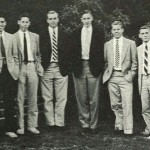
We have one more passing to report, although I was unable to find much information. Perhaps this post will attract some comments from readers who knew the man.
Frank Reilly was president of Brooks Brothers during the preppy ’80s, and retired shortly after the Marks & Spencer takeover. He died last October at the age of 90 and the news only just came on my radar. From his obituary:
After graduating from Columbia High School, he received his undergraduate degree from Lowell Textile Institute, Lowell, Mass., then his master’s of business from New York University. Frank started his career in retailing at Brooks Brothers then served as vice president and merchandise manager at Saks Fifth Avenue. He eventually returned to Brooks Brothers as president and chief executive officer where he retired in 1990 at the age of 62.











An undergraduate degree from the Lowell Textile Institute, eh? There’s an interesting history waiting to be written.
Lowell Tech was for many years known as the poor man’s MIT. Now U-Mass Lowell.
Which increasingly supports the notion that the school doesn’t make the man. The man makes the man!
NY Times, 6 October 1989:
Brooks Brothers, the New York-based apparel retailer, said yesterday that its chairman and chief executive, Frank T. Reilly, would retire at the end of the year.
Mr. Reilly, 62 years old, will be replaced by William V. Roberti, the president of the company, who will take the title of chief executive. Mr. Roberti, 42, joined the company two years ago after working at the Zale Corporation, a unit of People’s Jewellers Ltd., and Maas Brothers Inc. in Tampa, Fla., a subsidiary of the Campeau Corporation’s Allied Stores Corporation.
As part of the corporate realignment, Edward T. Murphy, executive vice president, will assume the post of chief operating officer.
Mr. Reilly has spent 25 years at Brooks Brothers. He has been chief executive since 1974, leading the company into the Japanese market, where it has 30 shops.
Under his direction, the company has expanded from 15 stores to 52. Brooks Brothers is a unit of Marks & Spencer P.L.C. of Britain
NY Times, 8 May 1976
Brooks Brothers, one of the nation’s venerable bastions of sartorial conservatism, is phasing out all custom tailoring.
The decision was attributed by Frank T. Reilly, the president, to the difficulty of getting qualified tailors and to a declining demand for the service.
The announcement of discontinuation of the bespoke service was made to its customers in letters sent out earlier this week.
“Well, I think it’s a shame,” said one of the customers, a 44‐year‐old midtown lawyer from Long Island’s North Shore, who declined to be further identified. “It marks the passing of an era.”
He said that he would continue to shop at Brooks, but that instead of buying its custom‐made suits, which were priced at between $500 and $600, he would buy from its special‐order department, where modifications for each customer are made on standard patterns and suits are priced at $350 to $400.
Mr. Reilly said he believed that the custom service, which will be closed out during the next few months, dated back fairly close to the origins in 1818 of Brooks Brothers, which is now owned by Garfinckel Brooks Brothers, Miller & Rhoads Inc. a department‐store and specialty‐store concern.
Mr. Reilly said no decision had yet been made on what would become of the customservice area in the Brooks Brothers flagship store at 346 Madison Avenue, at 44th Street.
In the quiet, green‐carpeted seventh‐floor enclave furnished with a leather chair and wood den table, burnished wooden shelves cradle bolts of suitings, shirtings and tweeds, and a model of headless busts model a variety of shirt‐collar styles.
The decision to end the cus. torn service, Mr. Reilly saido, involves seven or eight workers, who will remain with the store handling special‐order clothing.
“It has always been econom ically unsound,” Mr. Reilly said explaining the end of the service, “and so you couple that with the difficulty of getting the people and the dwindling demand for custom‐made garments—and part of that dwindling demand Is the custom‐made suit is so expensive that fewer and fewer people want them.”
He said that “from a fitting standpoint, 90 percent of the people can be satisfied” by the store’s special‐order service.
Still In Service
Custom service, however, is still very much alive at two nearby clothing stores that cater to men who prefer the traditional, conservative dress that has long been associated with Brooks Brothers. They are Chipp Inc. at 14 East 44th Street, and J. Press Inc. at 16 East 44th Street, between Madison and Fifth Avenues.
Richard E. Press, vice president of J. Press, agreed with Mr. Reilly that there was not an oversupply of qualified cus torn tailors. But, he said, the situation is better than it was a decade ago, when “it would be a triumph if we could get someone’s cousin to come in from Italy.”
Manny Eisenhandler, the manager of Local 4 of the New York Clothing Cutters, agreed. “Most of them come from Italy,” he said. “These are the old‐time tailors who would sit on a table cross‐legged and sew, and that’s a dying breed as far as I’m concerned.”
Reilly was right about full custom (bespoke) vs. “special order” (later made to measure?). Guessing the typical Brooks man wanted good cloth and tailoring, but didn’t give a damn about hand sewing throughout.
It would be great to see a pair of those 20-inch knee/20-inch bottom pants. The illusion of flare. A more modest version of “Oxford Bags.”
Apropos Brooks: any truth to the notion that the original ( “polo” collar featured 2.75″ points (length)? Contrasted with the two-inch “Clifford” button down collar, introduced during the 50s (and apparently well received).
“It would be great to see a pair of those 20-inch knee/20-inch bottom pants. The illusion of flare.”
Simple, just watch the 1974 version of The Great Gatsby, Ralph Lauren clothing and Robert Redford acting. Like all movie versions of the book they are mostly eye candy.
I wonder why come nobody can do that book justice in cinema. The 1970s attempt was the worst of all if you ask me.
“I wonder why come nobody can do that book justice in cinema. The 1970s attempt was the worst of all if you ask me.”
All great books or books you think are great are seldom adapted well. When you read a book you do the casting, directing, etc in your head.
I’m not really saying that the movies don’t live up to the book, but rather that this particular book hasn’t inspired great movies. Some great books inspire movies that are, not necessarily great interpretations of the books they’re based on, but that are great movies in themselves. To Kill a Mockingbird is an example. But for some reason this book is not one of those.
I can see how I didn’t really phrase that point well.
Is it just me or is the book wildly overrated? I understand why its so popular — the prose is quite simple and therefore eminently suited for high school reading lists. But for a discerning reader its a one-sit breeze. And I can’t blame Fitzgerald for this, but I find it rather ironic that the popular impression of the book focuses on Gatsby’s style and elegance when the intent, ultimately, is to ridicule the pretension and vulgarity of the ‘poseur’ Jay Gatz. Nor do we *really* care about his obsession or devotion to Daisy. Am I just totally wrong about this or do others feel the same?
Totally disagree. The book’s prose is sublime and Jay is meant to be sympathized with and pitied. It’s the cruel class divisions and the careless people in the upper parts of them that are the antagonists.
Ok but even if one agrees regarding the identity of the antagonists, it doesn’t relieve the irony of the popular misreading of Gatsby/Gatz, which sees him as some kind of exemplar of high society sophistication, when he quite demonstrably is not (the scene describing his closet full of brightly colored silk shirts is a comment on vulgarity, full stop). Also, by no means do I suggest that the prose is ‘bad’, only that it is simple, which I suggest accounts for the outsized position the book occupies in the culture (it is more accessible than other classics, i.e Faulkner etc.). Ultimately Gatsby is a nice little book, well executed perhaps, but I do think its reputation is vastly overblown. I much prefer Fitzgerald’s short stories, actually.
Oh yes, I agree that Gatsby is supposed to be a marvelous pretender, because that’s exactly what he is. But he’s not supposed to be a buffoon, badly aping high society. He’s someone who is pretty knowledgable about the so called better sorts because he had an extensive exposure and education on it in his youth. However, he can’t fully hide his true origins which emerge as conspicuous vulgarity. His attraction to bright colors, shiny cars, over the top parties, his overly practiced manner of speech, all serve to show who he truly is. But that is precisely why he’s such a pitiable character. He never had a chance in high society and so he never had a chance with Daisy. And Gatsby turns out to be the best of them after all because all he sees is goodness in a shallow, careless, woman.
So I guess what I’m trying to say is that Gatsby is likable precisely BECAUSE he’s vulgar and trying to survive in a world he doesn’t understand fully. And that was Fitzgerald’s point. Yes, we aren’t supposed to see Gatsby as the epitome of upper class style and manners, but Fitzgerald is telling us something more important. He’s telling us that upper class style and manners aren’t that grand a thing after all.
Absolutely yes your reading is quite right, in my opinion. And as far as it goes its a fine book, but my point is that it occupies this mammoth position in the culture based on a misconception (that it’s all a big opulent, roaring 20s party with Gatsby at the fun-wheeling centre). I remember being at a supposedly elegant restaurant in LA, can’t remember the name, and they had an oversized wall hanging of a smirking Leo Dicaprio holding a martini glass — a still from the latest adaption — and it just irked me to the core. Perhaps I’m letting that feeling overrun my assessment of the novel. It is also, undeniably, an easy one-sitting read, which in many respects IS a virtue in a novel, but I’m further irritated when I see it referenced as some challenging literary classic a la Moby Dick.
I disagree, but I’m also pretty certain at this point that I’m oriented to the literature I consume in a different way than you are. I had to stop repeatedly when reading it, not because it was a challenging read, but because of the sheer emotional power of it. But in any case, our differences of opinion seem to be a matter of taste so, salúd!